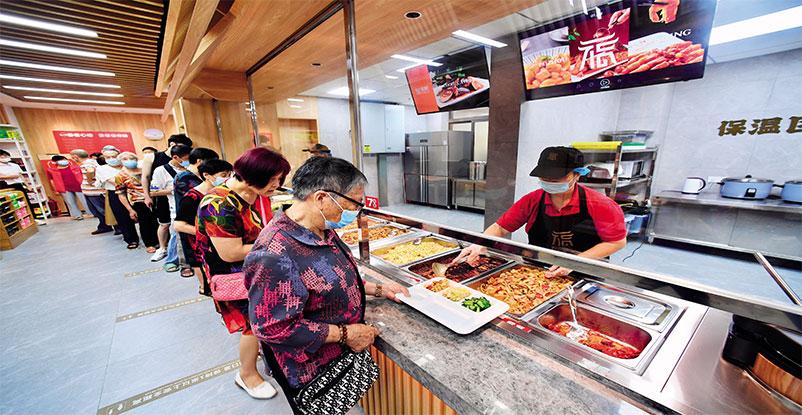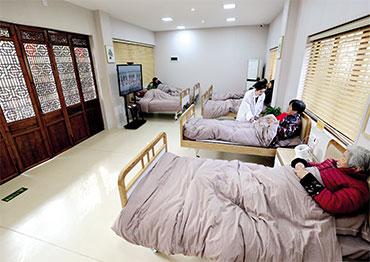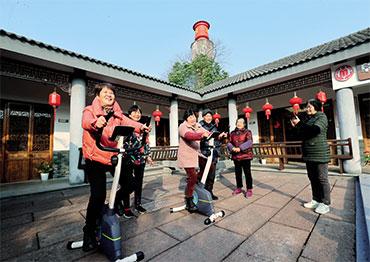According to the National Health Commission, by the end of 2018, 150 million, or 65 percent of the total 249 million elderly population, had chronic diseases, and 44 million lived with disabilities. However, Ministry of Civil Affairs data showed that there were only 400,000 certified elder care personnel and 298,000 nursing homes with 7.46 million beds, equating to 30 beds per 1,000 people aged over 60. In contrast, the US had 105 nursing home beds per 1,000 in 2019.
According to industry insiders, there is market potential for specialized elder care homes and community care service providers, as customers may pay a premium for tailored services. China needs more facilities and personnel for elder care. However, facing this uncontested market, the challenge for service providers is to explore a sustainable development model.
“The home- and community-care service industry offers meager profit potential,” Qian Xiaodong said. Compared to nursing homes, such services target a broader age range and economic bracket. The range and complexity of services required present significant challenges to service providers.
Wang Xiang told NewsChina that to avoid operating at a deficit, his food services company must meticulously calculate factors such as the number of meals per batch, how many chefs are needed and delivery costs. “With each meal priced at about 10-12 yuan (US$1.45- 1.74) profiting an average 1.5 to 2 yuan (US$0.22-0.29), labor costs alone will offset the meager profits,” Wang said.
In addition, elderly care services are predominantly non-profit. In most cities, both the government and enterprises have to provide resources. Consequently, their availability depends on the determination and financial strength of respective local governments.
Li Zhihong said that based on experiences in developed countries, the elder care industry initially starts as a state-funded, non-profit welfare undertaking. When a country’s per capita GDP reaches US$8,000-13,000, the industry enters a growth phase, focused on balancing welfare and industry development. At per capita GDP of US$13,000-26,000, the elderly care service industry matures, emphasizing market-oriented development. In 2022, China’s per capita GDP surpassed US$12,000, indicating the industry is on the verge of entering its mature phase.
In 2021, Wuxi’s market expanded as demand for government-purchased home-based services for the elderly rose. Previously limited to two elder care service providers, Wuxi now has five enterprises partnering with the local government.
“Elder care services require more than just enterprise support. The government should first give us a ‘pool’ to swim in,” Wang Xiao said. Scale operation is essential, and while Fukangtong provides home care services in provinces such as Jiangsu, Anhui and Shandong, their reach is limited to just several communities. In contrast, Wuxi’s Liangxi District allows them to operate on a much larger scale, covering over 70 square kilometers and serving around one million permanent residents.
Wang said that because of this much bigger service area, Fukangtong has employed over 300 housecleaners and over 100 nurses for the elderly of Liangxi District. Despite offering lower housecleaning rates, the steady market demand keeps employees satisfied. Wang’s company is also expanding their offerings, seeking profitable businesses opportunities such as adaptive innovation facilities for seniors.
Similarly, Taifu Elderly Care Service, Yang Li’s employer, launched market-oriented health care products and services alongside their government-contracted elderly canteens. Yang said the company offers food samples such as wonton, dumplings and stewed dishes for diners to try out and purchase. Taifu is also exploring long-term home care services for disabled and semi-disabled seniors.
Li Zhihong told NewsChina that elder care services should prioritize developing a comprehensive system with clear responsibilities for government, social organizations, enterprises and families, ensuring accessible basic care and public health services for all. Additionally, the elderly should be seen as a resource, not a burden. Li emphasized the need to engage market entities and social organizations to offer market-oriented products and services, tapping into the consumption potential of the elderly in areas such as culture, sports, tourism, finance and education. “We need to truly stimulate their economic vitality in these aspects,” Li added.
“Elder care is a societal concern, not only a civil affairs issue,” said Zhou Lijun. “In cultivating the elder care market, we need to explore more market-driven and socialized solutions, urge adult children to be attentive to their elderly family members’ needs, and for all parties to work together in understanding the aging population,” he added.

 Old Version
Old Version



